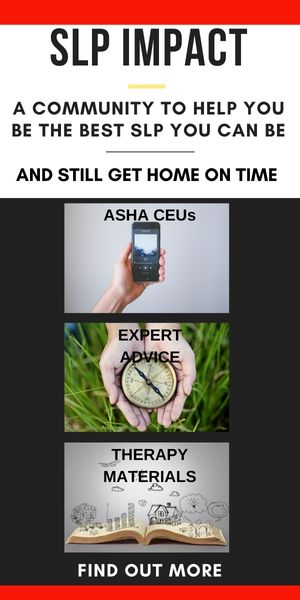I had a really meaningful exchange with an SLP Impact Member in California asking some really spot-on questions about bilingualism and its influence on speech, speech sounds, general vs. special education focuses and requirements, and much more. I want to share the questions and responses because, in aggregate, it paints a beautiful picture of the complexities we face each day and that fact that solutions do abound!
Kristina is a school-based SLP who first reached out for information on speech sounds, but as we went along, the nuances of interacting with staff, language information and qualifications became clear .
Let’s jump in!
1) I need definitive information to share with my administrators, teachers, and parents about determining a student’s articulation error is a difference, not a disorder.
For example, Student was born in Ukraine and came to the United States at age 5; parents speak Ukranian, Russian and English; Student is reported to only speak English. Student misarticulates /th/. No one disagrees /th/ sound is not found in Ukranian/Russian. Teacher/Admin/Parents want to work on the /th/ regardless; they don’t understand why it would be considered a difference because Student only speaks English. I have explained this but all of them are in disbelief because she speaks English. Please refer me to trainings or materials so that I can make this more concrete for them.
Response and Resources:
What your school is sharing about difference or disorder and cross linguistic influence is totally, common. The primary source of confusion is that YES teachers should cover differences in sound production, reading interpretation, and writing interpretation. Think /d/ for /th/. But NO, that does make it a special education issue or goal necessarily.
It’s made further problematic for them because, in other cases, we have speech goals that they also target for reading and writing. It’s not clear cut, so they deserve a good explanation and kudos to them for thinking about it.
However, if the student shouldn’t be on the caseload, there are several ways to explain the difference.
- On our Referrals page if you scroll down towards the bottom you will find a free powerpoint presentation and a script about What Makes a Good Speech Referral. That’s great to give to a group of teachers or even at a campus staff meeting. It’s about 10 minutes or so at a teacher in service, which dramatically improves your referrals.
- And as a speech pathologist, it sounds like you are a person who’s ultimately going to be asked a lot of questions on this topic. Check out the Difference or Disorder 1) Speech and 2) Language course for the full picture.
- Access to World Language Library to find the sounds that are shared and unshared between languages.
- Watch this video about the World Language Library
2) An SLP who does EL assessments said that you can’t just do an articulation assessment if you only have articulation concerns; you have to do a full assessment. Please advise.
Reading into what this SLP is saying, I see an argument for siding with her and I would also argue that “full assessment” can be interpreted different ways. The good news is that there is a fast way to capture data which takes a bit of the fear out of the words “full assessment.”
A) I don’t agree.
If the suggestion is that we can’t only test articulation that would not be correct.
- Tons of kids are unintelligible with typical language skills.
- Tons of kids are so unintelligible that language testing is not meaningful. We test artic and then circle back to language when intelligibility improves.
- Articulation has pretty elegant age-related time frames so seasoned teachers know immediately when a phonology or artic kid sticks out.
B) I do agree a teacher may refer a student for speech (the most obvious issue) when there is more going on so it’s important to look at the whole range of skill.
If the suggestion is that we can do some modified small test (screeners! Yuck!) that’s incorrect.
Screeners and standardized tests used in isolation miss and mis-identify so many kids. A “full evaluation is needed.” Full doesn’t have to mean a lot of work or an abusively long assessment process.
The Solution:
Full means:
- Parent opinion
- Teacher opinion
- Non-standardized testing
- Standardized testing
- Intelligibility measure
Using the language sampling tool, I can gather, transcribe, and analyze a communication sample in less than 10 minutes. We traditionally use “language sampling” for…language. Run it, mark errors and unintelligible words, count 100 or 200 words, and divide. You have your non-standardized testing/progress notes/referral concerns/intelligibility rating in one fell swoop.
3). What are the criteria to determine the native language?
Sadly, this is most often determined by whatever the parents said when the child enrolled, which could be years ago. Or, they only ask two questions: which language is spoken at home and which language is spoken at school.
The truth is that we need four pieces of information, taken today, not when the child entered the school system.
- How much English is heard at home.
- How much English is spoken at home.
- How much English is heard at school.
- How much English is spoken at school.
We created a free language exposure and use calculator to make this easy. Check it out.
4) Is it ever reasonable to consider that a student’s language difference would become a language disorder if that student only spoke English?
No.
5) How much weight is given to the family indicating what the students’ language upon enrollment? (They want to redesignate her so that she is no longer considered EL. That way she doesn’t have to take the ELPAC (test for EL development).
So this is a family choice and general education should support their decision. I used to be more opinionated about this one but after I began speaking to families about their decisions, they almost always had pretty strong convictions for what they were asking for. And, it was never simple. Here are some examples of what I have heard:
- A community family they know got a raw deal in education because their child was in “special classes” because they had limited English proficiency.
- They heard a rumor that the government was using education documents to target families for deportation.
- They have struggled with limited English as adults and want to save their child from the same pain.
Going back to #4, let’s say a family said the child spoke Hmong at home in Pre-K. Fast forward to 3rd grade, after 5 years of English exposure and living in this country, they are still classified from that 2019 box they checked. To your question, should any weight be given to this?
6) If they redesignate her, can I then work on it?
I want to caution not to get pulled into this argument either. This is a general education issue and we are special educators. We ALWAYS test in a second language if evidence suggests it’s necessary. We choose therapy targets that would apply to both languages. Both Hmong and English have all narrative components. Good goals. Hmong doesn’t have /th/. Bad goal.

Scenarios for Full Understanding
Kristina finished with four scenarios. Let’s use what we discussed above and see what to do in each of these situations. You will see that despite these scenarios seeming to be different, our solution is largely the same:
Scenario #1:
Student grew up in a Spanish speaking home. Parents reported her as speaking English only (on the school paperwork). Parents and the student both commented that she wasn’t really exposed to English until entering kindergarten.
Scenario #2:
The student is exposed to Spanish and English before entering school. How do you determine native language?
Scenario #3:
Regarding analysis of articulation of bilingual students. How is the native language determined? What if they grew a Spanish speaker grew up in a home that spoke both English and Spanish and now misarticulates the /th/?
Scenario #4:
Regarding a Russian or Spanish student who misarticulates the TH. They don’t qualify.
What if when they’re spelling the same way they’re saying the TH? So they spell “DAT” for “that”? Would that be considered impacting their curriculum and they would now qualify for an articulation disorder?
Solutions for Success
Referral:
Use the free referral documents and world language library to determine whether errors are only related to home-language influence. If the sounds in “error” (e.g. /th/) are not shared by both languages, it is not a good referral. If the sound error does not affect intelligibility (DAT for THAT) it is not a good referral. If the language patterns (e.g. noun-verb order) are not shared by both languages, it is not a good referral.
Use the free language exposure and use calculator to determine language levels.
Evaluation:
Use the Difference or Disorder Book and World Language Library to analyze a language sample. Use any of these 25 wordless picture books to capture the story. If the process does not exist in both languages, you can’t rule out home language influence. You shouldn’t qualify on these points alone.
Use the free language exposure and use calculator to determine which languages to test in.
Treatment:
Only target sounds that are shared by both languages. Only target language processes that are shared by both languages. Literacy-based intervention is the easiest decisions because all languages tell stories and have story components. Choose one these suggested SLP books. Search this blog for the many free essays on storybooks and literacy. Learn how to use literacy-based intervention effectively.



